Anatomy of a Pedestrian Village
For more about New Pedestrianism go to pedestrianvillages.com or newpedestrianism.com
A Pedestrian Village is the fullest expression of the New Pedestrianism urban design movement founded by Michael E. Arth in 1999. New Pedestrianism, in turn, is a more ecology and pedestrian-oriented branch of the New Urbanism movement that began in the early1990s. New Urbanism is primarily a revival of the old, pre-World War II urbanism commonly seen before World War II. Traditional urbanism included multi-tiered, cohesive communities with a rich tapestry of beloved buildings and institutions. New Urbanism revives the compact, walkable downtowns that included a mix of commercial and residential mixed-use. Storefronts are built close to the sidewalk, separated from the street with formal plantings of trees along streets properly scaled to pedestrians. Town squares, pocket parks, and other amenities enliven the public spaces.
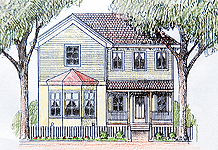
Typical front view of house from pedestrian lane
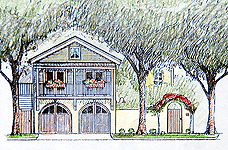
Street view at rear of house,
showing
"carriage house" and formal garden gate
New Pedestrianism takes all this a few steps further. Under New Urbanism there is usually a street in front and an alley in back. This is great for cars, but awful for pedestrians and cyclists. With New Pedestrianism, the alley in back is replaced with a serviceable, attractive tree-lined street along which one can find carriage houses (with garages below and housing above), formal garden gates and buried utilities. The street in front is turned into a tree-lined pedestrian lane that functions like a linear park thus increasing the charm and value of all properties. Pedestrian Villages provide for equal but separate networks for pedestrian/cyclists and cars.
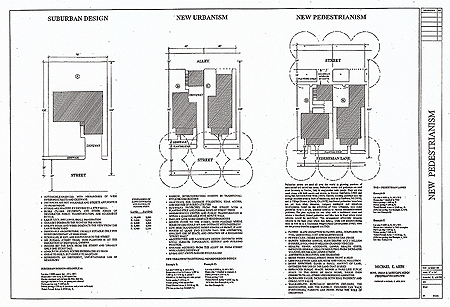
New Pedestrianism compared to typical suburban design and New Urbanism
Around 2018 we will begin moving out of the automobile age, which is characterized by sprawl development, wide roads and endless parking lots. In its place we will plunge deeper into the Information Age—characterized by a vastly fewer number of electric-powered, driverless shared cars and a parallel, fully immersive virtual world where most business and recreation will be conducted. For these reasons, it will become increasingly important for people to live in compact, ecologically sustainable communities that are beautiful, functional, and provide a wide range of healthy activities and amenities that make it easy and fun to get out, be active, and socialize.
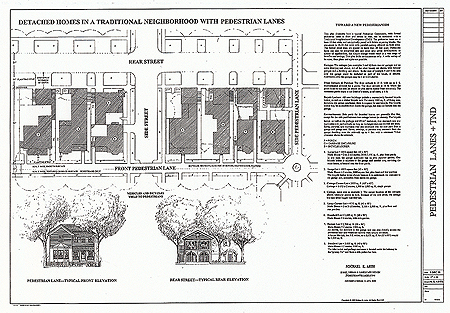
New Pedestrianism showing separate networks for cars and pedestrians
- PEDESTRIAN LANES: Minimum 12’ wide in front of all homes and businesses. The lane includes at least 7’ of smooth pavement for rolling conveyances like bicycles, Segways, skates, and wheelchairs, and a textured walkway at least 5’ wide indicates pedestrian use. The texture can be bricks, pavers, or stamped concrete. Pedestrians and the handicapped have priority at all times.
- STREETS: Every house and business has a street for automobile access at the rear, with the exception of the bungalow court, which has convenient off-street and on-street automobile access.
- VILLAGE CENTER: There are restaurants with a shared village plaza for lakeside dining. Mixed-use ground floor units can be offices, shops, live-work spaces, art studios, or other uses. Apartments are available on the second floor to provide a 24-hour presence. The dynamic village center is packed with amenities, services, recreation, and community spirit.
- SCALED DENSITY: Density is generally higher toward the center so that most people live within a short walk.
- HOUSING: There is a wide range of housing: 1. Katrina style cottages from 400-800 sq. ft. 2. Bungalows with 2-4 bedrooms. 3. Estate homes on larger lots. 4. Townhouses 5. Apartments or condominiums above the commercial buildings. 6. Carriage houses or guest cottages: 350-600 sq. ft.
- LAKE: A constant level lake is created in the lowest part of the development. Businesses and homes front Lakeview trail, a one-mile long tree-lined pedestrian lane around the lake. Cars or streets are generally not visible from Lakeview trail or any other pedestrian lane.
- RECHARGE POND: A large filtration system buried beneath the variable-level Willow Pond pumps filtered water into waterfalls on the main lake.
- STORM WATER: Storm water runoff from parking lots and major roads goes into the recharge pond for filtering before being pumped back into the lake through waterfalls. Newly created, natural-style surface streams handle some of the runoff. Storm drains draining into the recharge pond, the streams, or the lake next to the overflow stream handle the rest.
- WATER RECREATION: Clear, filtered water is pumped from below the recharge pond is at a near constant 72 degrees, the same as the average annual air temperature in this part of Texas. A series of waterfalls stair step down a hill in Palmetto Springs Park. The uppermost pool is a natural style pool with a simulated stone bottom. The lagoon has a sand bottom. The lagoon would be warmer than the pool in the summer and cooler in the winter.
- NATURE PRESERVES and PARKS: Las Palmas Island has native Texas palms. Palmetto Creek Park features a restored streambed. The existing deciduous woods will be augmented with palmettos and palms. The entire pedestrian lane system functions like a linear park with connections to formal parks, squares, plazas, fountains, greenbelts, and the water features.
- GREENBELTS: The village has greenbelts with created streambeds to filter surface drainage.
- CONNECTIVITY: The village is integrated into the surrounding community with the main street located next to a major road. Palmetto Creek Park and additional homes extend into the adjacent subdivision where existing homes will be ehabbed.
- ENERGY: Photovoltaic and solar water heating can be installed on top of nearly all buildings and homes. It will also be connected to the existing grid with net metering, and there is the possibility of building a solar energy generating plant on adjacent land owned by the developer.
- IRRIGATION: Existing wells and gray water can be used for irrigation. If a package plant is used to process wastewater, this water can also be used for irrigation.
- WATER SUPPLY: Well or city water.
- WASTEWATER: Options include connection to the city wastewater, or use of a package plant that recycles water into a created wetland that can be tapped for irrigation.
- FUTURE USE: This area can be for schools, medical facilities, water/wastewater processing, or other future development.
- FUTURE PLANNING: The parking area has conduits so that charging stations can be installed for electric cars, and eventually, self-driving electric cars. The village is designed for flexible, sustainable, mixed-use multi-generational living at all income levels.
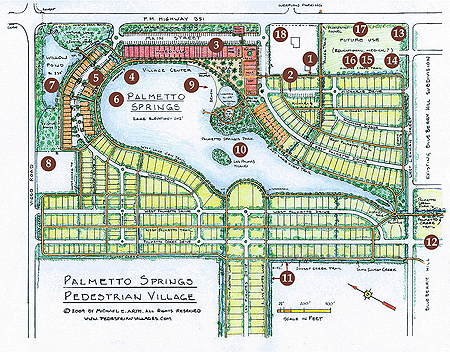
Anatomy of a Pedestrian Village. From the design for Palmetto Springs
(next to Beeville, Texas) designed by Michael E. Arth.